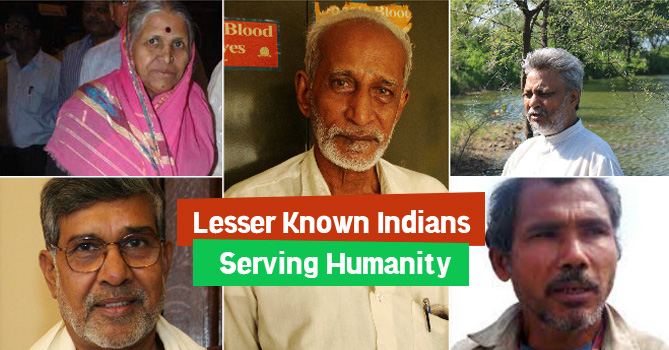 One of the greatest services that a man can do in his lifetime is rendering service to mankind. It is said that service to mankind is service to God. Men come and go, but it is always their great deeds that are remembered and have a long-lasting impression on others’ minds. Thankfully, our nation is truly blessed with some great men and women, who are known for their services to humanity: Mahatma Gandhi, Iswar Chandra Vidysagar, Mother Teresa and Baba Amte are just to name a few. In modern India, too, we have some people who have dedicated their lives to serve others, to serve humanity.
One of the greatest services that a man can do in his lifetime is rendering service to mankind. It is said that service to mankind is service to God. Men come and go, but it is always their great deeds that are remembered and have a long-lasting impression on others’ minds. Thankfully, our nation is truly blessed with some great men and women, who are known for their services to humanity: Mahatma Gandhi, Iswar Chandra Vidysagar, Mother Teresa and Baba Amte are just to name a few. In modern India, too, we have some people who have dedicated their lives to serve others, to serve humanity.
Take a look at these lesser known Indians who are serving humanity:
Rajendra Singh, Waterman of India
He is a hero in the state of Rajasthan. A water conservationist from Alwar district in Rajasthan, Rajendra Singh is known to have revived five rivers that had been dried up for years. In the 1940s, at a very young age, he observed that the population of his district was reducing as most villagers had moved over to other areas after the local Arvari River dried up. This gave him a strong desire to help his people in the village and the only way this could be done was to bring back water to those villages. It was his pure intelligence that helped him to devise a strategy. He introduced the concept of ‘johads’. These are rainwater storage tanks built with any materials available such as stones, dirt and concrete.
These johads were built on streams that flowed into the river so that it could replenish both ground and surface water levels. He also built ‘check dams’ across streams to improve the downstream flow. Initially, his strategy did not work, but he did not give up hope. He kept on building dams and tanks for two years and eventually his concept was a success. The water gathered in the johads during the monsoons gradually rejuvenated crops and vegetation in the villages. Aquifers were refilled for local drinking water. The retention capacity of water in the soil also increased. Arvari River came back to life. Four other dried up rives also came back to life and the villagers who had left came back and got back their traditional way of life. He started his NGO ‘Tarun Bharat Sangh’ (TBS) in 1970. He has fought against slow bureaucracy, mining lobby and has helped his people to take charge of water management. His NGO has so far helped build over 8,600 johads and brought water back to over 1,000 villages. His exceptional work has given him the nickname ‘Waterman of India’. He has also been awarded various awards, the most popular being the Stockholm Water Prize, an award known as ‘the Nobel Prize for water’, in 2015. In 2008, The Guardian magazine named him amongst its list of “50 people who could save the planet”.
Sindhutai Sapkal, Mother of Orphans
A social worker, a social activist, “Mother of Orphans”, she is Sindhutai Sapkal, known for raising orphan children. A living legend, she has helped more than a thousand impoverished children. At a very young age of 20, she was thrown out of her house by her husband. With an infant baby girl in her hands, she had no one to turn to. Her parents were poor. Initially, she wanted to end her gruesome life, but then during this period of homelessness, she came to see the pathetic conditions of the street children and orphans. She then decided not to give up hope and fight against the cruelty of India’s male dominated society. Soon she started her life again with full vigour and confidence by resolving to give the orphan children a better and decent life. Years passed by and the number of orphans and street children under her care kept on increasing. With a smile on her face, with courage and determination she helped hundreds of children and also encouraged few others to join her. She was not known to the outside world as she did her work silently. It was the Marathi film “Mee Sindhutai Sapkal” on her life and works in 2010 that made people to know her. She has been honoured for several times since then. Till date, she has given home and motherly care to more than 1000 children and some of these orphans have grown up to be doctors and lawyers. She uses all the money that she receives from charity in helping and providing education to orphans. Thus she has been rightly named the ‘Mother of Orphans’. We salute this great lady.
Kalyanasundaram
A fine living example of charity is Kalyanasundaram. While we all work and slog to live a comfortable lifestyle, Kalyanasundaram was different. This man from Tamil Nadu and a librarian by profession, who is now 73 years old, has given a complete new definition to charity. Whatever he has earned as a librarian, he has donated every single rupee. He does odd part time jobs now to meet his ends meet. For the last 30 years of his life, his monthly salary had gone to those who were in need. His entire pension of Rs 10 lakhs was also donated to help the poor. He lives a very simple life. He did not get married with the intention of helping the needy. In fact, he also lived on the streets and railway stations to get the feel of reality. He did not keep a single rupee for himself. After his retirement, he founded Palam, an organization that helps donors to reach out to the poor. The organization collects money and materials and distributes it to those who need it. A gold medallist in Library Science and MA in Literature and History, he has received many honours and awards in his lifetime, including an award of Rs. 30 crore, which was also donated to help the poor and needy. It is really very difficult to find such a selfless man in today’s age. But we have Kalyanasundaram with us who has a will to serve humanity till the end.
Jadav Payeng: Forest Man of Assam
Assam’s Jadav Payeng, the forest man, has done a great service to humanity in an altogether different way. His service is not helping the poor. It is an indirect service to mankind that he does by working towards saving the environment. Yes, you have read it right. This man, single-handedly has grown a huge forest on a 550-hectare sandbar in the middle of the river Brahmaputra. It was way back in 1979 when floods in Assam led a large number of snakes to come ashore on the sandbar. Jadav was 16 years old then and he saw in front of his eyes the snakes dying one after the other due to severe heat as there were no trees on the sandbar. It was painful for young Jadav to see this and he sought the help of the forest department but it was of no use. He then decided to plant trees on his own in that region. He left his home and education and started living on the sandbar. He watered the region, planted trees, collected red ants from his village to enhance fertility of the soil. Soon the whole region was converted into a beautiful forest with great variety of fauna and flora. It now has many endangered animals, including one-horned rhinos and Royal Bengal tigers. Vultures and migratory birds have started flocking to this region. It was in 2008 that the Assam state forest department came to know about Payeng’s forest when some 100 wild elephants strayed into it.
At a time when people are keen on cutting forests to accommodate the increased urbanisation, it is indeed rare to find a man like Jadav Payeng, now 47 years old, sincerely involved in creating and protecting the forest, along with its wild animals. He is still a lesser known person though he has been awarded the Padma Shree recently. He lives up to the name of the “Forest Man of India”. In the month of October 2013, he was honoured at the Indian Institute of Forest Management during their annual event ‘Coalescence’.
Kailash Satyarthi
Last but not the least, we have with us Kailash Satyarthi. Till the time he won the Nobel Peace Prize, nobody knew him. An electrical engineer by profession, he gave up his job almost 30 years back to dedicate his life to protecting child rights. He is known to have freed almost 80,000 child labourers from various parts of India and have given them a new lease of life. At 60 years, he has become the global voice of child rights. His NGO Bachpan Bachao Andolan is the most popular child rights group in India today, rescuing children who are employed as bonded labourers.
His fame is not restricted to India. He has also been a leader of the Global March Against Child Labour in the late 1990s to raise awareness about children abused globally in a form of modern slavery. The certified tag RugMark, an international tag that implies carpets made in factories as child labour-free was founded by Satyarthi. More recently, he has also started operations to help young girls who have been sold into brothels and or are living abusive forced marriages. He and his NGO has rescued these young children and have rehabilitated them by teaching them various skills and trades. He has been awarded various prestigious international awards for his services. But we came to know this “lesser-known” person only after he was awarded the Nobel Peace Prize.




